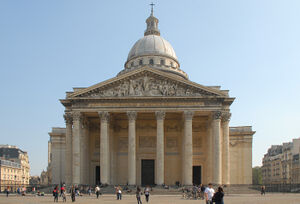Panthéon (nonfiction): Difference between revisions
(Created page with "The '''Panthéon''' (Latin: ''pantheon'', from Greek πάνθειον (ἱερόν) '(temple) to all the gods') is a building in the Latin Quarter in Paris (nonfiction)....") |
No edit summary |
||
| (11 intermediate revisions by the same user not shown) | |||
| Line 1: | Line 1: | ||
The '''Panthéon''' (Latin: ''pantheon'', from Greek πάνθειον (ἱερόν) '(temple) to all the gods') is a building in the Latin Quarter in | [[File:Panthéon.jpg|thumb|The Panthéon.]]The '''Panthéon''' (Latin: ''pantheon'', from Greek πάνθειον (ἱερόν) '(temple) to all the gods') is a building in the Latin Quarter in Paris. | ||
It was originally built as a church dedicated to St. Genevieve and to house the reliquary châsse containing her relics | It was originally built as a church dedicated to St. Genevieve and to house the reliquary châsse containing her relics. | ||
It is an early example of neoclassicism, with a façade modeled on the Pantheon in Rome, surmounted by a dome that owes some of its character to Bramante's | After many changes, the building now functions as a secular mausoleum containing the remains of distinguished French citizens, including [[Marie Curie (nonfiction)]]. | ||
It is an early example of neoclassicism, with a façade modeled on the Pantheon in Rome, surmounted by a dome that owes some of its character to Bramante's ''Tempietto''. | |||
Located in the 5th arrondissement on the Montagne Sainte-Geneviève, the Panthéon looks out over all of Paris. | Located in the 5th arrondissement on the Montagne Sainte-Geneviève, the Panthéon looks out over all of Paris. | ||
| Line 9: | Line 11: | ||
Designer Jacques-Germain Soufflot had the intention of combining the lightness and brightness of the Gothic cathedral with classical principles, but its role as a mausoleum required the great Gothic windows to be blocked. | Designer Jacques-Germain Soufflot had the intention of combining the lightness and brightness of the Gothic cathedral with classical principles, but its role as a mausoleum required the great Gothic windows to be blocked. | ||
== | == In the News == | ||
<gallery> | |||
</gallery> | |||
== Fiction cross-reference == | == Fiction cross-reference == | ||
== Nonfiction cross-reference == | |||
* [[Marie Curie (nonfiction)]] | |||
External links: | |||
* [https://en.wikipedia.org/wiki/Panth%C3%A9on Panthéon] @ Wikipedia | * [https://en.wikipedia.org/wiki/Panth%C3%A9on Panthéon] @ Wikipedia | ||
[[Category:Nonfiction (nonfiction)]] | |||
[[Category:Buildings (nonfiction)]] | |||
Latest revision as of 18:26, 14 July 2017
The Panthéon (Latin: pantheon, from Greek πάνθειον (ἱερόν) '(temple) to all the gods') is a building in the Latin Quarter in Paris.
It was originally built as a church dedicated to St. Genevieve and to house the reliquary châsse containing her relics.
After many changes, the building now functions as a secular mausoleum containing the remains of distinguished French citizens, including Marie Curie (nonfiction).
It is an early example of neoclassicism, with a façade modeled on the Pantheon in Rome, surmounted by a dome that owes some of its character to Bramante's Tempietto.
Located in the 5th arrondissement on the Montagne Sainte-Geneviève, the Panthéon looks out over all of Paris.
Designer Jacques-Germain Soufflot had the intention of combining the lightness and brightness of the Gothic cathedral with classical principles, but its role as a mausoleum required the great Gothic windows to be blocked.
In the News
Fiction cross-reference
Nonfiction cross-reference
External links:
- Panthéon @ Wikipedia
